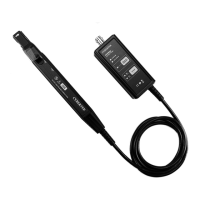Shenzhen Zhiyong Electronics Co., Ltd
7.2 Degaussing and Zero setting
Connect the HCP8000 with oscilloscope (Make sure the input impedance of the oscilloscope is 1MΩ)
Lock the probe until the UNLOCK symbol disappear.
Press the button to degauss and zero set. There will be beeping as success indication after 6s
7.3 Measuring method
Confirm the previous steps
Pull the switch control pole of the sensor, open the head of the sensor and make the current direction mark in
front of the sensor accordance with the current under test, and put the conductor under test in the middle of
the sensor.
Push the switch control pole of the sensor until the UNLOCK mark disappear. Lock the probe, make sure the
entire part is closed, and then observe the waveform under test. Utilize the current transfer ratio to transform
the voltage sensibility into current sensibility. For instance, the ratio of HCP8030 is 0.1V/A (30A range), and
then, when the voltage sensibility of the waveform monitor is 10mV/div, the current sensibility is
100mA/div.
8. The method to deal with abnormal situation
Can’t measure DC, or the value
obtained is comparatively low in
the frequency range
Oscilloscope set to AC coupling
Auto degaussing or zero setting
unsuccessful
The probe is on the operating circuit
under test when degaussing or zero
setting is applied
Turn off the circuit under test and
zero set again.
The amplitude is comparatively
low in the frequency range
The input resistance of the test
equipment like oscilloscope is 50Ω
Set the resistance over 1MΩ
9. Q&A
9.1 Does HCP8000 series fit the oscilloscope of any brand?
A: HCP8000 series has standard BNC interface can be applied to the oscilloscope of any brand. It is
powered by standard adapter, independent of oscilloscope power, so it is very easy to use.
9.2 Can HCP8000 series product measure small current?
A: Yes. For now, the HCP8000 series current probe has two optional ranges, and one is for small current.
The current resolution of the HCP8030(D) is 1mA. When measuring small current, please accurately zero set
and degaussing the probe, and do not change the position of the probe hand grip. To observe the waveform
please set the bandwidth restriction of the oscilloscope to 20MHz to eliminate the interference of noise.
When measuring extremely small current (a few mA for example), one could make a few more loop of cable
around the probe and divide the result with number of loop to obtain the actual current value.
9.3 Any more tips?
A:
When measuring high frequency current, please do not let the current surpass the value shown by the
curve of max peak current vs frequency. The max continuous current over the curve will burn the probe.

